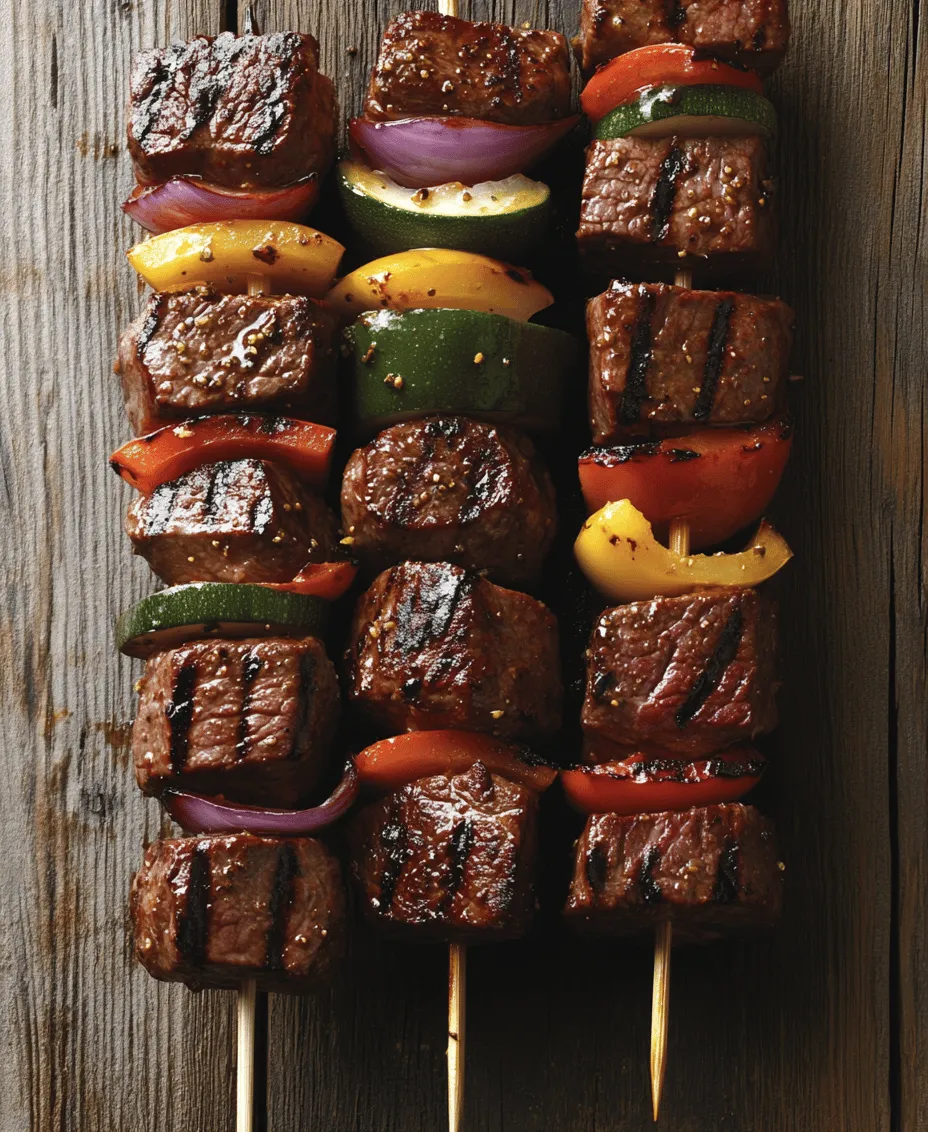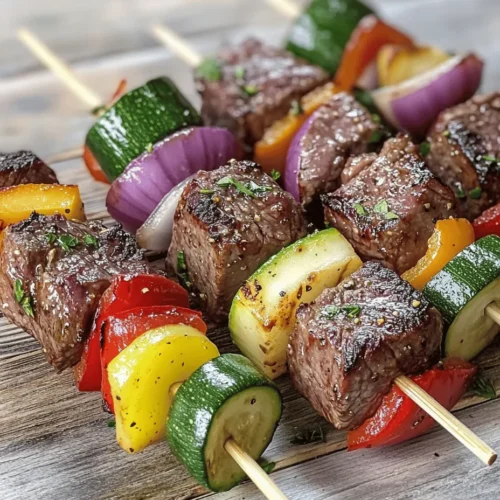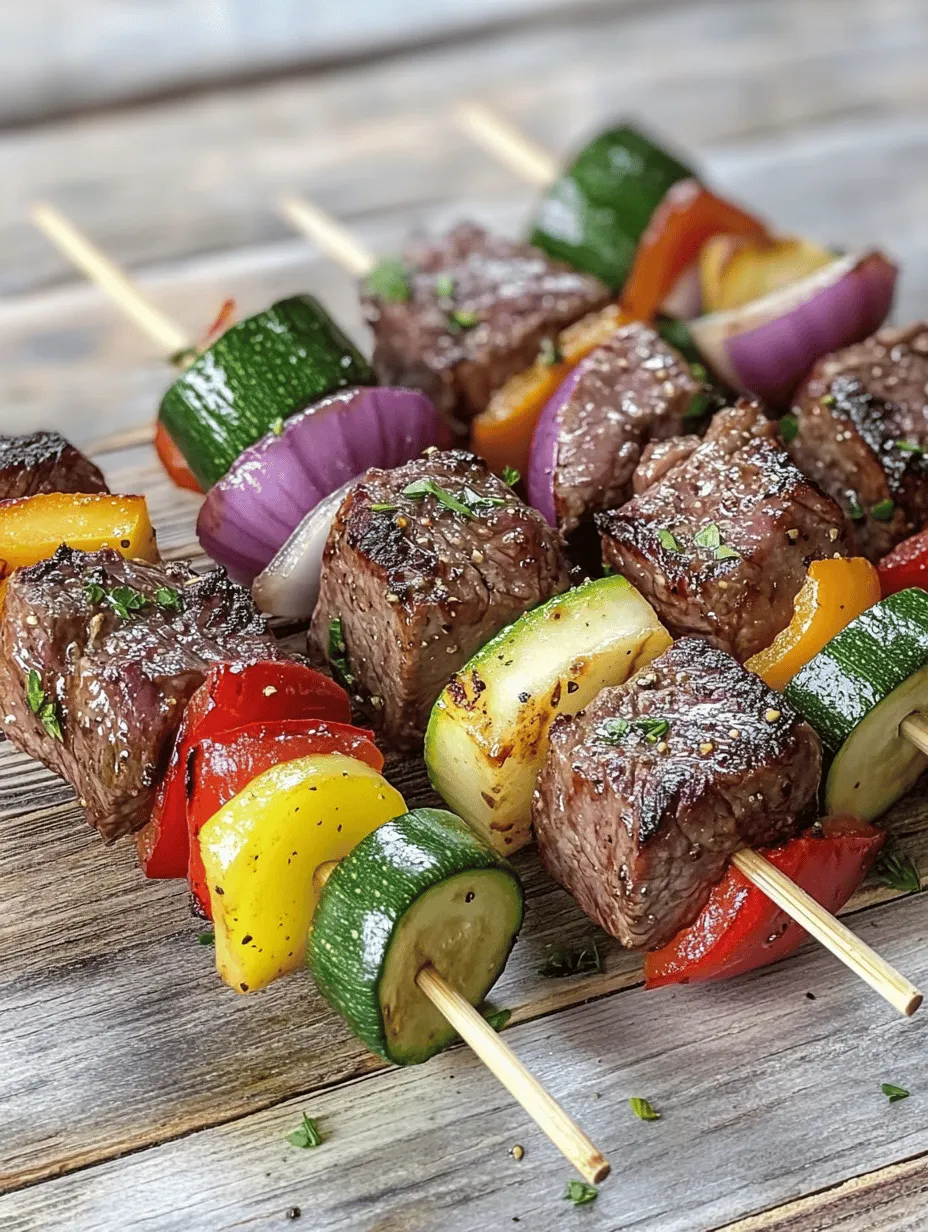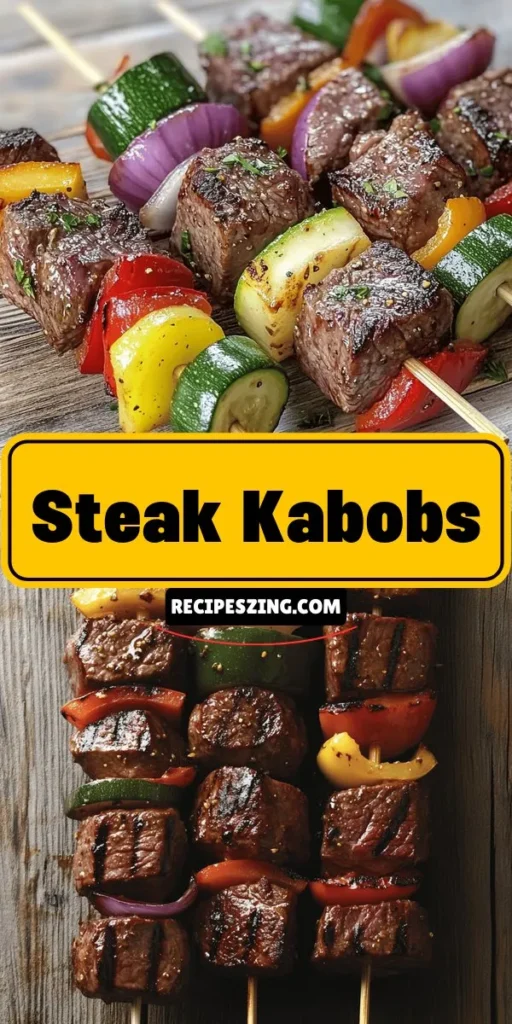Grilling season is upon us, and what better way to celebrate than with sizzling steak kabobs? These delightful skewers are not only a feast for the eyes but also deliver a burst of flavor that makes every bite memorable. Steak kabobs are the epitome of summer cooking, combining tender marinated meat with vibrant vegetables, making them a favorite at backyard barbecues and family gatherings. The appeal of steak kabobs lies in their versatility; you can customize the ingredients according to your preference, making them suitable for everyone—from meat lovers to vegetarians.
Grilling has long been a cherished culinary tradition across cultures, symbolizing the art of cooking over an open flame. It transforms simple ingredients into mouthwatering dishes, infusing them with smoky flavors that are simply irresistible. The act of grilling not only enhances the taste but also brings people together, creating shared experiences around the fire. Sizzling steak kabobs embody this spirit, offering a dish that is easy to prepare and perfect for social occasions.
Understanding the Ingredients
The Star of the Dish: Sirloin Steak
At the heart of every great steak kabob is the sirloin steak. This cut of beef is renowned for its balance of tenderness and flavor, making it an ideal choice for grilling. Sirloin is relatively lean compared to other cuts, such as ribeye, yet it retains enough marbling to ensure it remains juicy and flavorful during cooking.
Nutritionally, sirloin steak offers several benefits. It is packed with protein, essential for muscle growth and repair, and contains important vitamins and minerals such as B vitamins, iron, and zinc. These nutrients play a crucial role in maintaining energy levels and overall health. When selecting sirloin for kabobs, look for cuts that are bright red with a fine grain; this indicates freshness and quality.
The Role of Vegetables in Kabobs
While the sirloin steak is the star, it’s the supporting cast of vegetables that elevates the dish to another level. Bell peppers, red onions, and zucchini are not only colorful additions but also contribute their own unique flavors and textures.
– Bell Peppers: These vibrant veggies add a sweet crunch to the kabobs. They come in various colors—red, yellow, and green—each offering a slightly different flavor profile. Besides their taste, bell peppers are also loaded with vitamins A and C, making them a nutritious choice.
– Red Onion: Known for its slightly sweet and tangy flavor, red onion adds depth to the kabobs. When grilled, they caramelize beautifully, enhancing their sweetness and adding a chewy texture that contrasts nicely with the tender steak.
– Zucchini: This versatile vegetable absorbs flavors well and provides a mild taste that complements the beef. Grilled zucchini has a tender, slightly crispy texture that adds a refreshing element to the dish.
Marinating Essentials
One of the keys to achieving flavorful steak kabobs is a good marinade. Marination is not merely a step in the recipe; it’s an essential technique that enhances the overall taste and tenderness of the meat. The right marinade penetrates the steak, infusing it with flavors that elevate the dish from ordinary to extraordinary.
A classic kabob marinade typically includes a combination of acid, oil, and seasoning. The acid—often from ingredients like vinegar or citrus juice—helps to break down the proteins in the meat, making it tender. The oil allows for even distribution of flavors and helps prevent the meat from drying out during cooking. Seasonings, such as garlic, herbs, and spices, add depth and complexity to the flavor profile.
Breakdown of Marinade Ingredients
1. Olive Oil: Acts as a base for the marinade, ensuring that flavors adhere to the meat while providing moisture.
2. Soy Sauce: Adds a rich umami flavor and helps tenderize the steak.
3. Garlic: Fresh minced garlic introduces a robust aromatic quality to the marinade.
4. Lemon Juice: The acidity of the lemon juice brightens the flavors and aids in tenderizing the meat.
5. Herbs: Fresh or dried herbs such as rosemary, thyme, or oregano can be included to enhance the flavor.
By allowing the steak to marinate for at least 30 minutes (or ideally, several hours or overnight), you’ll maximize the flavor absorption, resulting in kabobs that are deeply seasoned and utterly satisfying.
Step-by-Step Guide to Making Sizzling Steak Kabobs
Marinating the Steak
To begin your journey to the perfect steak kabob, start with marinating the sirloin. This step is crucial for flavor enhancement and tenderness. Here’s how to do it:
1. Prepare the Marinade: In a bowl, combine olive oil, soy sauce, minced garlic, lemon juice, and your choice of herbs. Whisk together until well blended.
2. Cut the Steak: Trim any excess fat from the sirloin and cut it into 1- to 1.5-inch cubes. This size ensures even cooking and makes for easy skewering.
3. Combine: Place the steak cubes in a resealable plastic bag or a shallow dish. Pour the marinade over the steak, ensuring that each piece is well coated.
4. Seal and Refrigerate: If using a bag, seal it tightly, removing as much air as possible. If using a dish, cover it with plastic wrap. Refrigerate for at least 30 minutes, but for best results, let it marinate for 2 to 8 hours.
Preparing the Vegetables
While the steak is marinating, it’s time to prepare the vegetables. Choosing fresh, high-quality produce will enhance the overall flavor of the kabobs.
1. Selecting Fresh Produce: Look for firm bell peppers, vibrant red onions, and fresh zucchini without blemishes or soft spots. The vegetables should be bright and full of color, indicating freshness.
2. Cutting the Vegetables:
– Bell Peppers: Remove the seeds and stem, then cut into 1-inch squares.
– Red Onion: Cut the onion into quarters, then separate the layers for easy skewering.
– Zucchini: Slice the zucchini into ½-inch thick rounds to ensure even cooking.
3. Optional Pre-marination: If you want to enhance the flavor of the vegetables, you can toss them in a little olive oil and sprinkle with salt and pepper. This step is optional but can add an extra layer of flavor.
Assembling the Kabobs
With the steak marinated and the vegetables prepared, it’s time to assemble the kabobs.
1. Skewering: Begin by taking skewers—either metal or soaked wooden skewers to prevent burning. If using wooden skewers, soak them in water for at least 30 minutes before grilling to avoid them catching fire.
2. Arranging the Ingredients: Start sliding on a piece of steak, followed by a bell pepper, a piece of onion, and a zucchini slice. Repeat this pattern until the skewer is filled, leaving a little space between each ingredient to allow for even cooking.
3. Visual Appeal: For a stunning presentation, alternate colors and textures as you assemble the kabobs. The combination of red, green, and yellow not only looks appealing but also adds to the flavor experience.
Preheating the Grill
Before placing the kabobs on the grill, it’s essential to preheat it. This step helps achieve the perfect sear on the meat and ensures that the vegetables cook evenly.
1. Heat the Grill: Preheat your grill to medium-high heat, aiming for around 400°F to 450°F. If you’re using a charcoal grill, ensure the coals are glowing and covered with white ash.
2. Oil the Grate: To prevent sticking, lightly oil the grill grates using a paper towel dipped in oil, held with tongs.
With your kabobs assembled and the grill preheated, you’re now ready to cook up a storm! The following steps will detail how to grill your sizzling steak kabobs to perfection, ensuring they are juicy, flavorful, and a hit with everyone at your gathering. Stay tuned for the next part of this recipe, where we’ll explore the grilling process and share tips for serving these delightful skewers.

Grilling steak kabobs is not just about throwing skewers on the grill; it’s an art that combines the right temperature, timing, and technique. Achieving perfectly cooked kabobs requires attention to detail, especially when it comes to grill temperature and the cooking process. Let’s delve into the essential steps for grilling your kabobs to perfection, serving suggestions, nutritional information, cultural significance, and wrap up with some final thoughts.
Importance of Grill Temperature for Perfect Cooking
One of the most crucial aspects of grilling steak kabobs is achieving the right grill temperature. The ideal grill temperature for kabobs is between 400°F and 450°F. This range allows for a good sear on the meat and vegetables, creating that coveted char while ensuring the insides remain juicy and tender.
Tips for Checking Grill Readiness
To determine if your grill is at the right temperature, you can use a few simple methods:
1. Hand Test: Hold your hand about 5 inches above the grill grate. If you can only hold it there for 2-4 seconds, the grill is hot (around 400°F). For 5-7 seconds, it’s medium heat (around 350°F).
2. Thermometer: If you have a grill thermometer, this is the most accurate method. Place it on the grill grate and wait for the reading.
3. Visual Cues: If you see a steady stream of smoke and hear a sizzle when you place food on the grill, you’re likely at the right temperature.
Grilling the Kabobs to Perfection
Monitoring Cooking Times
Cooking times for steak kabobs can vary based on the size of the meat and vegetables, as well as the grill temperature. Generally, kabobs take about 10-15 minutes to cook. It’s important to monitor them closely, flipping the skewers every 3-4 minutes to ensure even cooking.
Insights on Doneness Levels and Internal Temperature
For steak kabobs, the internal temperature is crucial for achieving your desired level of doneness:
– Rare: 125°F
– Medium Rare: 135°F
– Medium: 145°F
– Medium Well: 150°F
– Well Done: 160°F and above
Use a meat thermometer to check the internal temperature of the steak. Remember, the steak will continue to cook slightly after being removed from the grill, so it’s wise to take it off a few degrees below your target temperature.
Importance of Turning Kabobs for Even Cooking
Turning your kabobs is essential for achieving even cooking. As the meat and vegetables cook, they can char on one side while remaining undercooked on the other. Rotate the skewers every few minutes to ensure all sides get that perfect grill mark and cook thoroughly.
Achieving the Perfect Char
The perfect char on steak kabobs comes from a combination of high heat and the right timing. Allow the kabobs to sear without moving them for the first few minutes. Once they develop a nice crust, you can start turning them. This not only enhances the flavor but also improves the visual appeal of the dish.
Techniques for Ensuring Vegetables are Tender and Meats are Juicy
To ensure the vegetables remain tender while the beef is juicy, consider the following tips:
1. Pre-soak Wooden Skewers: If using wooden skewers, soak them in water for at least 30 minutes before grilling to prevent burning.
2. Cut Uniformly: Ensure all meat and vegetable pieces are of similar size to promote even cooking.
3. Use Marinades: Marinades infuse flavor and help tenderize tougher cuts of meat. Acidic ingredients like vinegar or lemon juice work particularly well.
4. Cooking Order: If using a mix of meats and vegetables, place firmer vegetables (like bell peppers and onions) next to the meat and softer vegetables (like zucchini) at the ends of the skewers.
How to Avoid Common Grilling Pitfalls
Grilling can sometimes lead to common pitfalls that detract from the overall experience. Here are a few to avoid:
– Crowding the Grill: Leave enough space between kabobs for airflow. This helps achieve better heat distribution and prevents steaming.
– Opening the Grill Too Often: Each time you open the grill, you lose heat. Try to keep the lid closed as much as possible to maintain a consistent temperature.
– Not Using Enough Oil: Lightly oiling the kabobs before grilling can help prevent sticking and promote a good char.
Serving Suggestions
Once your sizzling steak kabobs are perfectly grilled, it’s time to present them in a way that excites the senses.
Presentation Tips for Serving Kabobs
– Colorful Arrangement: For an appealing presentation, alternate meat and colorful vegetables on the skewers. This not only looks beautiful but also enhances flavor with each bite.
– Garnish: Add fresh herbs like parsley or cilantro for a pop of color and freshness. Lemon wedges can also add a vibrant touch.
Suggested Dipping Sauces that Complement the Dish
Enhance the flavor of your steak kabobs with a variety of dipping sauces:
1. Tzatziki: A refreshing yogurt-based sauce with cucumber and garlic.
2. Chimichurri: A herby sauce made with parsley, garlic, vinegar, and oil, perfect for steak.
3. Spicy Sriracha Mayo: A creamy and spicy option that adds a kick.
Ideas for Side Dishes to Enhance the Meal Experience
Pair your kabobs with sides that complement their robust flavors:
– Rice Options: Serve with fluffy jasmine rice or a flavorful pilaf.
– Salads: A tangy Greek salad or a refreshing cucumber salad can balance the richness of the kabobs.
– Grilled Vegetables: Continue the grilling theme with a side of grilled corn or asparagus.
Nutritional Information
Understanding the nutritional profile of your steak kabobs can help you enjoy them guilt-free.
Breakdown of Calories, Protein Content, and Other Nutritional Facts Per Serving
On average, a serving of steak kabobs (about 3 skewers) provides:
– Calories: 350-400
– Protein: 25-30 grams
– Fat: 20 grams
– Carbohydrates: 5-10 grams
– Fiber: 2-3 grams
Discussion on Health Benefits of the Ingredients Used
Steak provides a rich source of protein, essential for muscle growth and repair. The added vegetables contribute vitamins, minerals, and antioxidants, promoting overall health. Using lean cuts of meat and incorporating a variety of vegetables can make this dish a healthy choice for any meal.
Cultural Significance of Kabobs
Kabobs have a rich history and hold cultural significance across various cuisines.
Brief History of Kabobs in Different Cuisines
Originating in the Middle East, kabobs have become a beloved dish in many cultures, each adding unique flavors and ingredients. From the Middle Eastern shish kebab to the Mediterranean souvlaki, these skewered delights have transcended borders, evolving into numerous variations.
Variations of Kabobs Across Cultures
Each culture offers its unique twist on kabobs. In India, for instance, seekh kabobs made with spiced minced meat are popular. In Turkey, döner kebabs are deliciously marinated and shaved meat served with pita. Each variation reflects local tastes and ingredients, showcasing the versatility of kabobs.
The Role of Kabobs in Social Gatherings and Celebrations
Kabobs are not just a meal; they are a social experience. Commonly served at barbecues, picnics, and family gatherings, they encourage sharing and enjoying food together. The act of grilling kabobs can turn mundane evenings into memorable celebrations.
Conclusion
The satisfaction derived from making and enjoying sizzling steak kabobs is unparalleled. The tender, juicy meat paired with vibrant vegetables creates a dish that is not only delicious but also visually appealing. As you perfect this recipe, don’t hesitate to experiment with different ingredients and marinades to find your ideal flavor profile.
Grilling is more than just cooking; it’s about connection, joy, and sharing meals with loved ones. So fire up your grill, gather your family and friends, and enjoy the delightful experience that comes with making and sharing steak kabobs. Happy grilling!



